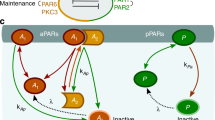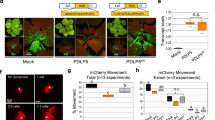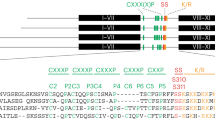Abstract
PDZ protein interaction domains are typically selective for C-terminal ligands, but non-C-terminal, 'internal' ligands have also been identified. The PDZ domain from the cell polarity protein Par-6 binds C-terminal ligands and an internal sequence from the protein Pals1/Stardust. The structure of the Pals1–Par-6 PDZ complex reveals that the PDZ ligand-binding site is deformed to allow for internal binding. Whereas binding of the Rho GTPase Cdc42 to a CRIB domain adjacent to the Par-6 PDZ regulates binding of C-terminal ligands, the conformational change that occurs upon binding of Pals1 renders its binding independent of Cdc42. These results suggest a mechanism by which the requirement for a C terminus can be readily bypassed by PDZ ligands and reveal a complex set of cooperative and competitive interactions in Par-6 that are likely to be important for cell polarity regulation.
This is a preview of subscription content, access via your institution
Access options
Subscribe to this journal
Receive 12 print issues and online access
$189.00 per year
only $15.75 per issue
Buy this article
- Purchase on Springer Link
- Instant access to full article PDF
Prices may be subject to local taxes which are calculated during checkout





Similar content being viewed by others
Accession codes
References
Pawson, T. & Nash, P. Assembly of cell regulatory systems through protein interaction domains. Science 300, 445–452 (2003).
van Ham, M. & Hendriks, W. PDZ domains-glue and guide. Mol. Biol. Rep. 30, 69–82 (2003).
Harris, B.Z. & Lim, W.A. Mechanism and role of PDZ domains in signaling complex assembly. J. Cell. Sci. 114, 3219–3231 (2001).
Doyle, D.A. et al. Crystal structures of a complexed and peptide-free membrane protein-binding domain: molecular basis of peptide recognition by PDZ. Cell 85, 1067–1076 (1996).
Songyang, Z. et al. Recognition of unique carboxyl-terminal motifs by distinct PDZ domains. Science 275, 73–77 (1997).
Harris, B.Z., Lau, F.W., Fujii, N., Guy, R.K. & Lim, W.A. Role of electrostatic interactions in PDZ domain ligand recognition. Biochemistry 42, 2797–27805 (2003).
Hillier, B.J., Christopherson, K.S., Prehoda, K.E., Bredt, D.S. & Lim, W.A. Unexpected modes of PDZ domain scaffolding revealed by structure of nNOS–syntrophin complex. Science 284, 812–815 (1999).
Gee, S.H. et al. Cyclic peptides as non-carboxyl-terminal ligands of syntrophin PDZ domains. J Biol. Chem. 273, 21980–21987 (1998).
Christopherson, K.S., Hillier, B.J., Lim, W.A. & Bredt, D.S. PSD-95 assembles a ternary complex with the N-methyl-D-aspartic acid receptor and a bivalent neuronal NO synthase PDZ domain. J Biol. Chem. 274, 27467–27473 (1999).
Hurd, T.W., Gao, L., Roh, M.H., Macara, I.G. & Margolis, B. Direct interaction of two polarity complexes implicated in epithelial tight junction assembly. Nat. Cell Biol. 5, 137–142 (2003).
Lemmers, C. et al. CRB3 binds directly to Par6 and regulates the morphogenesis of the tight junctions in mammalian epithelial cells. Mol. Biol. Cell 15, 1324–1333 (2004).
Peterson, F.C., Penkert, R.R., Volkman, B.F. & Prehoda, K.E. Cdc42 regulates the Par-6 PDZ domain through an allosteric CRIB-PDZ transition. Mol. Cell 13, 665–676 (2004).
McGee, A.W. et al. Structure of the SH3-guanylate kinase module from PSD-95 suggests a mechanism for regulated assembly of MAGUK scaffolding proteins. Mol. Cell 8, 1291–1301 (2001).
Makarova, O., Roh, M.H., Liu, C.J., Laurinec, S. & Margolis, B. Mammalian Crumbs3 is a small transmembrane protein linked to protein associated with Lin-7 (Pals1). Gene 302, 21–29 (2003).
Roh, M.H. et al. The Maguk protein, Pals1, functions as an adapter, linking mammalian homologues of Crumbs and Discs Lost. J. Cell Biol. 157, 161–172 (2002).
Otwinowski, Z. & Minor, W. Processing of X-ray diffraction data collected in oscillation mode. Methods Enzymol. 276, 307–326 (1997)
Navaza, J. Implementation of molecular replacement in AMoRe. Acta. Crystallogr. D Biol. Crystallogr. 57, 1367–1372 (2001).
Brunger, A.T. et al. Crystallography & NMR system: A new software suite for macromolecular structure determination. Acta. Crystallogr. D 54, 905–921 (1998).
Jones, T.A., Zou, J.-Y. & Cowan, S.W. Improved methods for building models in electron density maps and the location of errors in these models. Acta Crystallogr. A 47, 110–119 (1991).
Winn, M.D., Isupov, M.N. & Murshudov, G.N. Use of TLS parameters to model anisotropic displacements in macromolecular refinement. Acta. Crystallogr. D 57, 122–133 (2001).
Acknowledgements
We thank A. Berglund, T. Stevens, B. Volkman, and members of the Prehoda Lab for helpful comments and suggestions. We thank the support staff at beamline 8.2.1 at the Advanced Light Source for technical assistance. This work was supported by grants from the American Heart Association, National Institutes of Health (GM068032), and a Damon Runyon Scholar Award to K.E.P.
Author information
Authors and Affiliations
Corresponding author
Ethics declarations
Competing interests
The authors declare no competing financial interests.
Supplementary information
Supplementary Fig. 1
Electron density maps. (PDF 10090 kb)
Supplementary Fig. 2
B-factor plot. (PDF 636 kb)
Supplementary Fig. 3
Heteronuclear NOEs. (PDF 653 kb)
Supplementary Fig. 4
Real space correlation coefficients. (PDF 626 kb)
Rights and permissions
About this article
Cite this article
Penkert, R., DiVittorio, H. & Prehoda, K. Internal recognition through PDZ domain plasticity in the Par-6–Pals1 complex. Nat Struct Mol Biol 11, 1122–1127 (2004). https://doi.org/10.1038/nsmb839
Received:
Accepted:
Published:
Issue Date:
DOI: https://doi.org/10.1038/nsmb839
This article is cited by
-
Autoregulation of the LIM kinases by their PDZ domain
Nature Communications (2023)
-
Targeting PDZ domains as potential treatment for viral infections, neurodegeneration and cancer
Biology Direct (2021)
-
Influenza virus infection causes global RNAPII termination defects
Nature Structural & Molecular Biology (2018)
-
modPDZpep: a web resource for structure based analysis of human PDZ-mediated interaction networks
Biology Direct (2016)
-
Cryptic protein-protein interaction motifs in the cytoplasmic domain of MHCI proteins
BMC Immunology (2016)



